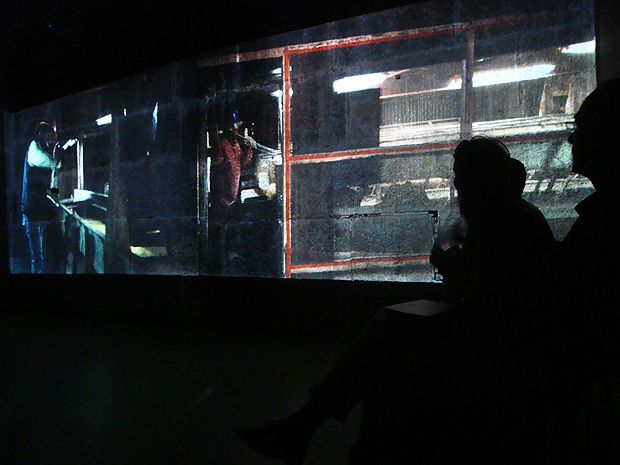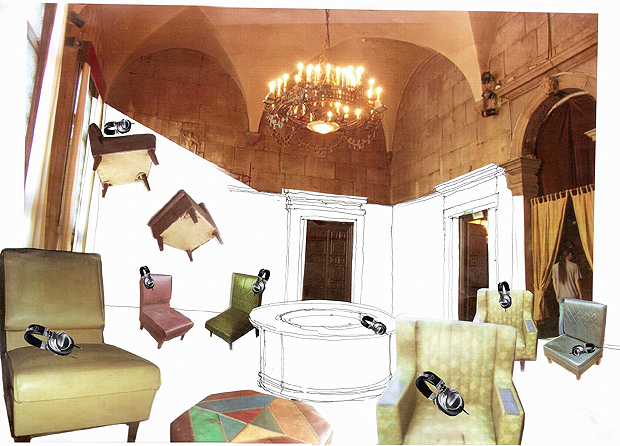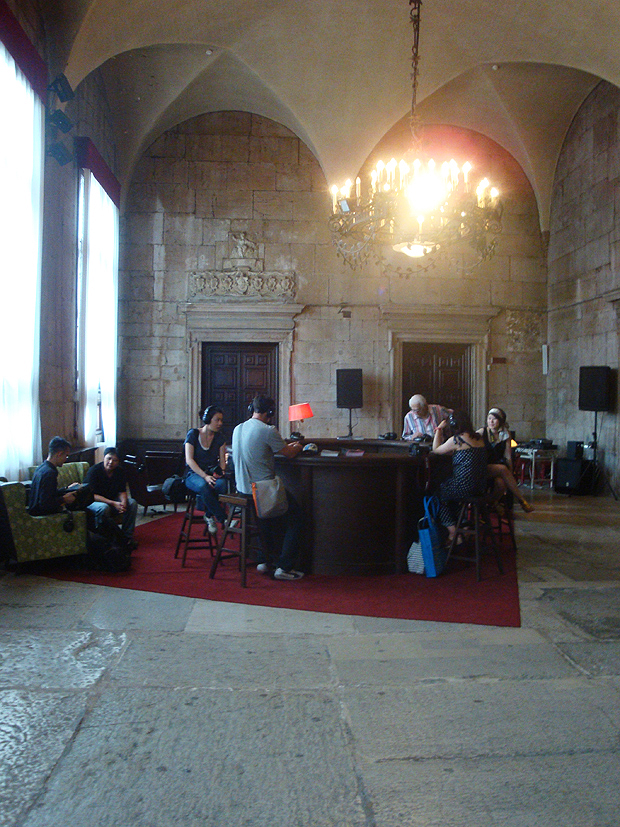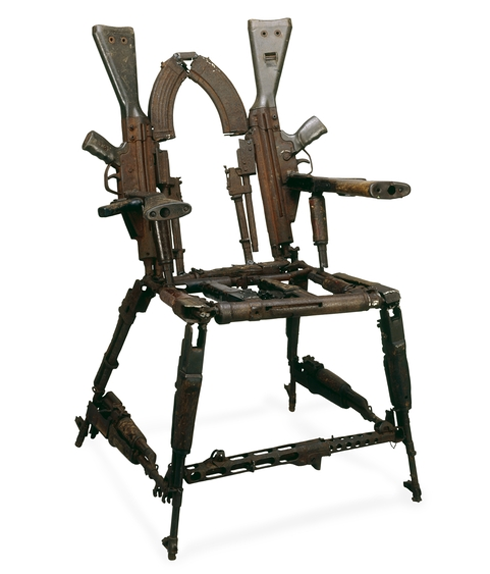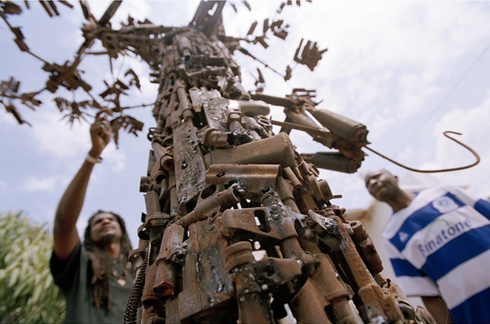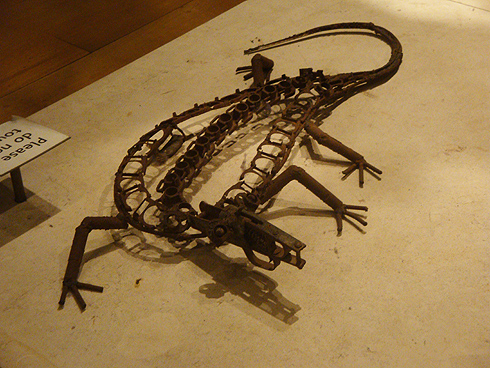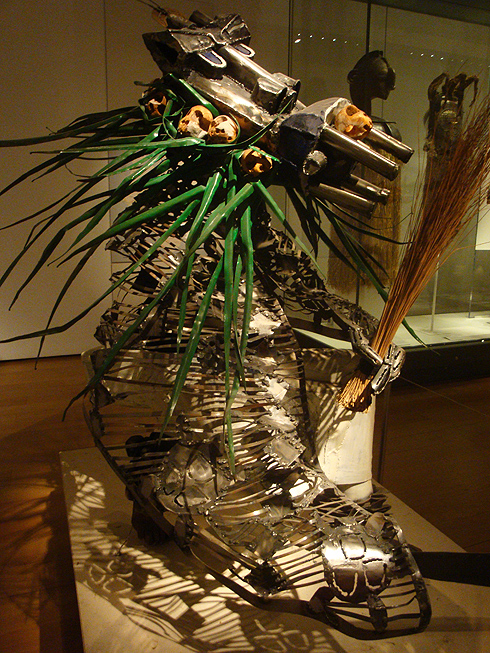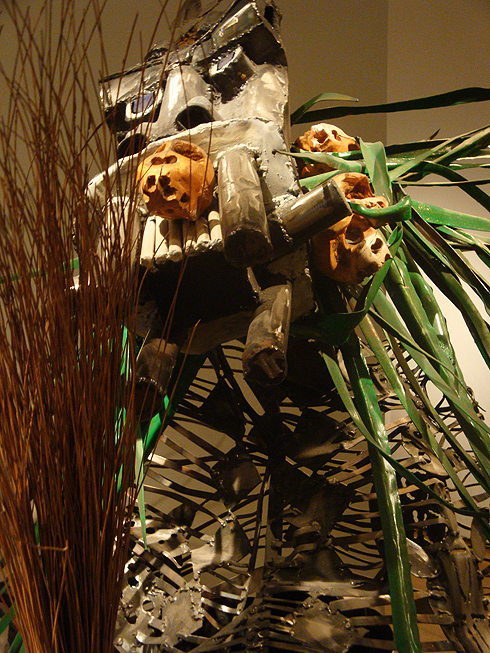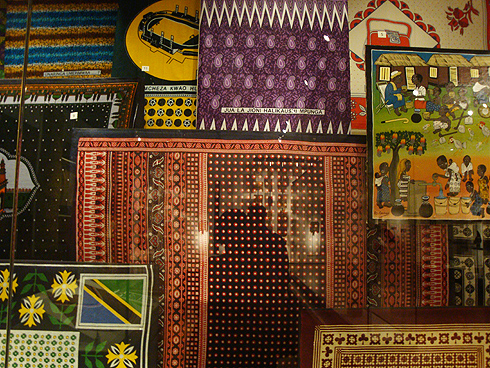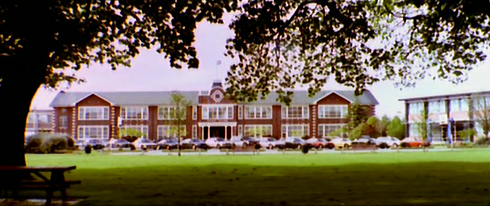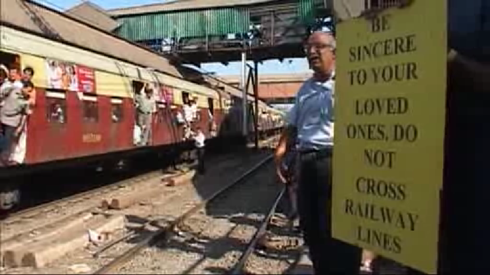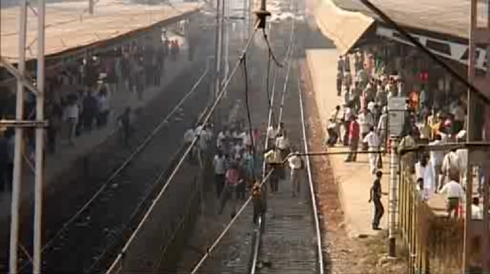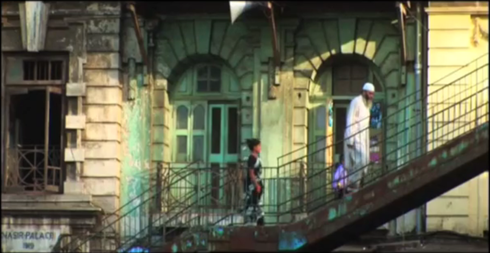More on Shadows
In his essay In Praise of Shadows Japanese novelist Tanizaki writes about the conflict between western and eastern aesthetics in the modern world. He says that Japanese 'find beauty not in the thing itself but in the patterns of shadows, the light and the darkness, that one thing against another creates.' He emphasizes beauty in subtlety and that which cannot be seen too clearly, leaving some of the experience to our imagination. Pallasmaa talks of something similar when he emphasizes the importance and intimacy of darkness.
In his essay In Praise of Shadows Japanese novelist Tanizaki writes about the conflict between western and eastern aesthetics in the modern world. He says that Japanese 'find beauty not in the thing itself but in the patterns of shadows, the light and the darkness, that one thing against another creates.' He emphasizes beauty in subtlety and that which cannot be seen too clearly, leaving some of the experience to our imagination. Pallasmaa talks of something similar when he emphasizes the importance and intimacy of darkness:
The eye is the organ of distance and separation, whereas touch is the sense of nearness, intimacy and affection. The eye surveys, controls and investigates, whereas touch approaches and caresses. During overpowering emotional experiences, we tend to close off the distancing sense of vision; we close our eyes when dreaming, listening to music, or caressing our beloved ones. Deep shadows and darkness are essential, because they dim the sharpness of vision, make depth and distance ambiguous, and invite unconscious peripheral vision and tactile fantasy. (Pallasmaa, 1996, p.46).
Pallasmaa continues to say that bright lights kill our imagination whereas twilight, dimly lit spaces and foggy scenes spark our sense of mystery, the mystical and mythological. Tanizaki also mentions this sense of tranquility and calm in shadows, that which separates the inside from the outside:
Whenever I see the alcove of a tastefully built Japanese room, I marvel at our comprehension of the secrets of shadows, our sensitive use of shadow and light. For the beauty of the alcove is not the work of some clever device. An empty space is marked off with plain wood and plain walls, so that the light drawn into its forms dim shadows within emptiness. There is nothing more. And yet, when we gaze into the darkness that gathers behind the crossbeam, around the flower vase, beneath the shelves, though we know perfectly well it is mere shadow, we are overcome with the feeling that in this small corner of the atmosphere there reigns complete and utter silence; that here in the darkness immutable tranquility holds sway. (Tanizaki, 1977).
In my work there is a combination of bright light that hurts the eye and multiple shadows. Parts of the space are brighter and dimmer than others. The views of the city begin with twilight, continue to sunset and then cycle back to twilight in an endless loop. Various kind of shadows are present in the work, those that are glaring and sharp and others that are subtle and noticeable only after an amount of time spent in the space. Due to a feedback loop dim mirror versions of yourself are also visible in the walls, each a mere second after the next. The overall effect is an experience which is disconcerting as you see several shadows of yourself, the other in the walls on either side. Despite bright lights the audience cannot see the entire work because the city is fragmented with shadows. The gaps and shadows leave the final interpretation up to the audience themselves. It is an experience which aims to express the inner conflict of the city, which I call Mumbai.
Reference: Pallasmaa, J. (1996). Eyes of the Skin: Architecture and the Senses. John Wiley & Sons: UK. Sowin, J. (2006). In Praise of Shadows: A Meditation. [online]. Available from:http://www.fireandknowledge.org/archives/2006/09/23/in-praise-of-shadows-a-meditation/ [Accessed 17th August 2011]. Tanizaki, J. (1977). In Praise of Shadows. Leete's Island Books: USA
Post-Traumatic Urbanism
Cities like Mumbai and Beirut have developed in unstable uncertainty and in many ways are resilient survivors. They have adapted with 'redundant networks' and 'diversity and distribution' rather than 'centralized efficiency' which makes them flexible in the face of shocks to infrastructure (Lahoud, 2010).
Mumbai as a city has undergone several traumatic events in the past few years. Those in my direct memory and experience are the 26/11 attacks and the painfully recent 2011 bombings. Earlier I argued that despite these tragic events the city in essence remained the same. How does a city survive these traumatic events whether they are natural flash floods or terror attacks, and in what way does it change? Today people try to understand how cities survive and evolve through math and science. As a philosophy urbanism states that cities are vitally important to the progress of humanity. In his talk The Surprising Math of Cities and Corporations, West argues that cities are both the solution and the problem, underlining their bipolarity.
And the tsunami of problems that we feel we're facing in terms of sustainability questions, are actually a reflection of the exponential increase in urbanization across the planet... However, cities,despite having this negative aspect to them, are also the solution. Because cities are the vacuum cleaners and the magnets that have sucked up creative people, creating ideas, innovation, wealth and so on. So we have this kind of dual nature. (Geoffrey West, 2011)
West explains why cities are so successful when he says 'You could drop an atom bomb on a city, and 30 years later it's surviving. Very few cities fail.' Mumbai as a city has survived several traumatic events over the past two hundred years, though nothing on such a catastrophic level. It is an ancient place that has been ruled by a succession of invaders. There is even evidence that suggest that the islands have been colonized by humans since the Stone Age. Each event in this recorded and unrecorded past have changed the landscape and its people, but I am most interested in its recent traumas.
So cities are extremely successful, bipolar creatures. But how do traumas affect them? Philosopher and critical theorist Andrew Benjamin says that 'trauma involves a more complex sense of place.' He proposes that the city contains forgotten and repressed settings that are beyond memory but always present, creating an 'estrangement' and sense of the 'unaccustomed' when such events return.
The term 'post-traumatic' refers to the evidence of the aftermath - the remains of an event that are missing. The spaces around this blind spot record the impression of the event like a scar. (Lahoud, 2010. p.19).
Cities like Mumbai and Beirut have developed in unstable uncertainty and in many ways are resilient survivors. They have adapted with 'redundant networks' and 'diversity and distribution' rather than 'centralized efficiency' which makes them flexible in the face of shocks to infrastructure (Lahoud, 2010). When it comes to events like the most recent bomb attack in 2011, the city picked up the pieces and went on the next day as if nothing had happened. Local trains continued to run. The event was given its significant narrative by the media and the places that were bombed were cleared up. Memories and the gaps created by such violence will always remain an intrinsic part of the city's architecture. But it is Mumbai's impenetrable resilience in the face of such catastrophes that fascinates me. Events such as 9/11 in a first world country completely derailed the city, but in Mumbai it was in many ways business as usual. But forgetting like we do in Mumbai does not erase the hurt.
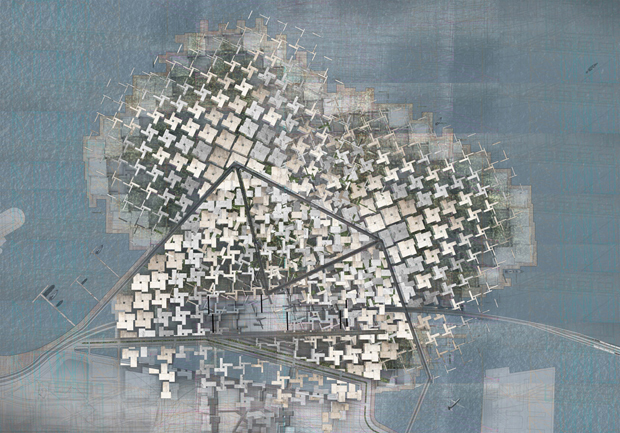 The Diversity Machine and Resilient Network, 2009. Social Transformation Studio. Martin abbot, Georgia Abbot, Clare Johnston, Joshua Lynch and Alexandra Wright.
The Diversity Machine and Resilient Network, 2009. Social Transformation Studio. Martin abbot, Georgia Abbot, Clare Johnston, Joshua Lynch and Alexandra Wright.
Anthony Burke says that the reason cities are so difficult to predict is that they are very complex systems 'growing at the edge of chaos.' Even small events can lead to avalanche-like conditions because both natural and human-made catastrophes display a self-organizing criticality or the:
...tendency of large systems with many components to evolve into a poised, `critical' state, way out of balance, where minor disturbances may lead to events, called avalanches, of all sizes. Most of the changes take place through catastrophic events rather than by following a smooth gradual path. The evolution to this very delicate state occurs without design from any outside agent. The state is established solely because of the dynamical interactions among individual elements of the system: the critical state is self-organized. Self-organized criticality is so far the only known general mechanism to generate complexity. (Per Bak, 1997, p.1).
The idea that a city is on the verge of chaos is not far from many narratives in western popular culture. The accepted line is that just one push is enough to bring the whole system crumbling down. However the theory above is not as simple as that, these systems are large and therefore extremely difficult to destroy completely. Its heartening to see that even human cities are in the end, part of nature, and follow patterns similar to natural phenomenon such as weather.
Although there are no definitive answers to what post-traumatic urbanism is the term itself raises critical questions and discussion. An often quoted statistic today is that the urban world is larger than the rural world, which underlines the importance of trying to understand urban trauma and its effect on the city and its people. In my journey to capture the essence of Mumbai, to explore unexpressed feelings of conflict created by repressed events and resolve my own perceptions and experience; it is this complexity which is central to understanding my art.
Reference: Benjamin, A. (2010). Trauma within the Walls: Notes towards a philosophy of the city. Architectural Design. Vol. 80. No.5. pp.24-31. Burke, A. (2010). The Urban Complex: Scalar probabilities and Urban Computation. Architectural Design. Vol. 80. No.5. pp.87-91. Lahoud, A. (2010). Post Traumatic Urbanism. Architectural Design. Vol. 80. No.5. pp.14-23. Per Bak. (1996). How Nature Works: The Science of Self-Organised Criticality. Copernicus Press: New York. West, G. (2011). The Surprising Math of Cities and Corporations. [online]. Available from http://www.ted.com/talks/geoffrey_west_the_surprising_math_of_cities_and_corporations.html [Accessed 2nd Aug. 2011].
Dayanita Singh
I am especially interested in her attempts to express her own visions of a place or city, opposing the singular story people usually expect about India, that of 'sensational catastrophes and human failures'
Phil mentioned Singh in connection to my work on Mumbai because of her series of photographs titled Dream Villa. Her landscape images of Mumbai resonate with the kind of video I'm using for my installation. I am especially interested in her attempts to express her own visions of a place or city, opposing the singular story people usually expect about India, that of 'sensational catastrophes and human failures' (Cotter, H. 2005). Dream Villa 11. 2008. Dayanita Singh [Image Source]
House of Love 2010. Dayanita Singh. [Image Source].
Reference: Cotter, H. 2005. Objects of Repose and Remembrance. New York Times. [online]. Available from: http://www.nytimes.com/2005/03/30/arts/design/30cott.html?ex=1172638800&en=840b508f152bce9e&ei=5070 Date Accessed: 21st July 2011.
Degen, N. 2008. Dayanita Singh. Frieze Magazine. [online]. Available from: http://www.frieze.com/shows/review/dayanita_singh/. Accessed: 21st July 2011.
Dayanita Singh: House of Love. La Lettre. [online]. Available from: http://lalettredelaphotographie.com/entries/dayanita-singh-house-of-love. Date Accessed: 7th August 2011.
Collaboration: The Third Hand
Through collaboration the singular voice of the artist is muted or dispersed, it is a break away from a singular artistic identity. The author introduces the idea of a 'third hand,' or ghost artist which is an elusive other or combined identity created in collaborative works. This third independent existence is in itself 'uncanny' because such a constructed ghost identity 'blurs the distinction between the real and phantasmic.'
[A summary of ideas from the book The Third Hand - Collaboration in Art from Conceptualism to Postmodernism].
The book focusses on a period of western art history during the 1960's and 1970's which the author identifies as the beginnings of artist collaboration, a conscious movement away from individual lone artists making work in a conventional studio. He describes and classifies three kinds of collaborative artist teams. What most interested me in the discussion of the meanings and motivations behind various types of collaboration, was the issue of identity.
Through collaboration the voice of the artist is muted or dispersed, it is a break away from a singular artistic identity. The author introduces the idea of a 'third hand,' or ghost artist which is an elusive other or combined identity created in collaborative works. This third independent existence is in itself 'uncanny' because such a constructed ghost identity 'blurs the distinction between the real and phantasmic.'
The author's discussion of the uncanny helped me better understand my previous collaborative project Tobari No Akari 2. Using dolls, dream-like doubles and shadow doubles the images we created are surreal and uncomfortable, bringing forth memories from childhood but in a disconcerting way. We could also say that creating ghost doubles in the installation references the joint artistic will of the collaboration and work itself.
The video shown below is an attempt to document the collaborative process where we arranged and re-arranged the installation over several hours. It highlights the importance of collaboration as a method of creating more avenues of future work; as well as the potential for it to be a work of art in terms of performance.
The author also talks about artists that use collaboration as a means to escape personal limits and language, to travel beyond conventional authorship and representations of identity, or a 'relativisation and reformation of self.' I felt this was especially relevant to the motivation behind my collaborative projects; however I hesitate to deconstruct or over-explain the experience for fear of losing sense of its meaning and to some extent, its mystery.
Site-Specific Art
In his book Eyes of the Skin, Pallasmaa talks at great length about the beauty of human perception and how the senses interact with each other to form experience. He emphasizes the importance of a sense experience as a whole. He says there is a bias to the eye in the architectural practice because people are focussed on how a building looks rather than how a body can move within it or how it feels. When it comes to the perception of places he discusses the importance of emotion, memory, imagination and fantasy.
During my research into place-making in phase two I briefly discussed the rigidity of a panoramic city view and my attempts to break it by framing unfamiliar cityscapes, using shadows and through collaboration. The book is relevant to my studies because it discusses creating place, the transitive nature of site, framing and virtual and 'real' spaces. The author describes monuments as loci's of power and authority (Kaye, 2000) in his chapter on Performing the City. This underlines the rigidity of the panorama since monuments are an iconic part of them. A relevant example is Mumbai's famous Nariman Point which is named after a historical Congress party leader and contains Indian and international financial institutions and government buildings such as CBI, RBI, Mittals, Birla's, JP Morgan, Merrill Lynch, Vidhan Sabha etc.
Monumentality […] always embodies and imposes a clearly intelligible message. It says what it wishes to say - yet it hides a good deal more: being political, military and ultimately fascist in character" (Lefebvre, 1991 cited in Kaye, 2000, p. 34).
He also discusses the relation between the body and the city or built environment and the body and the space, which in this case is the installation space in artist Wodiczko's work. A completely artificial and constructed installation is also a built environment. People interact with the architecture of the city, and similarly the audience interacts with the architecture of installation. The artist says that 'Our position in society is structured through bodily experience with architecture' (Wodiczko, 1992 cited in Kaye, 2000, p. 38).
In the installation test below, the audience directly affects an abstracted view of the city. In this constructed space people can directly change and affect an image of the architecture, making it fluid and interchangeable.
The author says 'where the site functions as a text perpetually in the process of being written and being read, then the site-specific work's very attempt to establish its place will be subject to the process of slippage, deferral and indeterminacy in which its signs are constituted' (Kaye, 2000, p. 183).
Further reading lead me to Merleau-Ponty's theories of phenomenology and perception where he discusses the essence of perception and experience. He says that we cannot separate our minds and bodies from our perception of the world, or in other words that we are 'condemned to meaning' (Merleau-Ponty, 1962, p. xxii). In his book the Phenomenology of Perception he discusses the relationship between reflective and unreflective experience, psychological and physiological aspects of perception, and consciousness as a process that includes feeling and reasoning.
We must not, therefore, wonder whether we really perceive a world, we must instead say: the world is what we perceive. (Merleau-Ponty, 1962, xviii).
In his book Eyes of the Skin, Pallasmaa talks at great length about the beauty of human perception and how the senses interact with each other to form experience. He emphasizes the importance of a sense experience as a whole. He says there is a bias to the eye in the architectural practice because people are focussed on how a building looks rather than how a body can move within it or how it feels. When it comes to the perception of places he discusses the importance of emotion, memory, imagination and fantasy:
We have an innate capacity for remembering and imagining places. Perception, memory and imagination are in constant interaction; the domain of presence fuses into images of memory and fantasy. We keep constructing an immense city of evocation and remembrance, and all the cities we have visited are precincts in this metropolis of the mind. (Pallasmaa, 2005, p.67).
In my attempts to create a feeling of conflict within the city, a subtle realization of the bipolarity within Mumbai, the result was a space that could not be expressed as a still image. Not could it be expressed by only video. By adding a third dimension of time and motion, where the audience themselves make the image change and break the city is read as something in constant flux.
I know myself only in my inherence in time and in the world, that is, I know myself only in ambiguity. (Merleau-Ponty, 1962, p.402).
Reference: Kaye, N. 2000. Site-Specific Art: Performance, Place and Documentation. Routledge: London Merleau-Ponty. 1962. Phenomenology of Perception. Routledge: London. Pallasmaa, J. (2005). Eyes of the Skin: Architecture and the Senses. John Wiley & Sons: UK. View Wodiczko's Bio & Work in detail.
Group Critique 3
Other mentionable works where the audience completes the piece are Tall Ships by Gary Hill and Anthony McCall's work with light.
During the critique Charlie Murphy mentioned several interactive artists that could help inform my work. Paul Sermon's Telematic Dreaming is one such installation which explores real and projected audience interactions.
Other mentionable works where the audience completes the piece are Tall Ships by Gary Hill and Anthony McCall's work with light. Helen Maurer's use of projectors with mirrors is relevant because of relationships drawn between the real and virtual.
 High Tide 2006. by Helen Maurer. Overhead projector, glass, mirror and painted wood. [Image Source]
High Tide 2006. by Helen Maurer. Overhead projector, glass, mirror and painted wood. [Image Source]
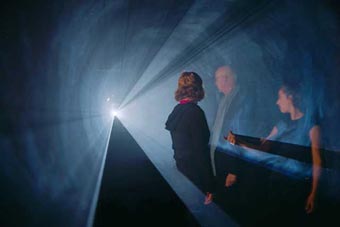 Anthony McCall. Line Describing a Cone. (1973, 16mm film) at the Whitney Museum exhibition “Into The Light,” 2001-2. Photograph © Henry Graber, 2002.
Anthony McCall. Line Describing a Cone. (1973, 16mm film) at the Whitney Museum exhibition “Into The Light,” 2001-2. Photograph © Henry Graber, 2002.
Charlie also mentioned the essay In Praise of Shadows by Jun'ichirō Tanizaki, which is a beautiful discussion of aesthetics and the conflict between west and east. Since my final work uses different types of shadows in the installation, Tanizaki's writing helped me look at metaphorical layers behind the shadow and differences in cultural meanings and perception. During the presentation some interesting quotes from Eyes of the Skin by Julian Pallasmaa caught my attention and when I had the book in my hands I discovered the chapter The Significance of the Shadow, which added to my increasing knowledge of how different theorists contextualize the shadow and its perceived meanings.
Reference Tanizaki, J. 1977. In Praise of Shadows. Leete's Island Books: USA Pallasmaa, J. 1996. Eyes of the Skin: Architecture and the Senses. John Wiley and Sons: USA
The Heard and Unheard
'By constructing an "architectural music-space...made possible by the microphone," Music While We Work explores how artistic practice can intervence in the social space of labor production at the intersection of history and everyday life.'
At the Taiwan pavilion, artists' Hong-Kai Wang and Yi-Hsien Su created soundscapes that transformed the way I look at how sound can be used in installation work. Hong-Kai Wang's work especially connected with my attempts to use sound to comment on Mumbai's atmosphere and culture. She says,
'By constructing an "architectural music-space...made possible by the microphone," Music While We Work explores how artistic practice can intervene in the social space of labor production at the intersection of history and everyday life.'
Hong-Kai WANG. Music While We Work. Huwei, Yunlin, Taiwan. 2011. Audio and video installation. Video still by Yann Tonnar. Courtesy Hong-Kai WANG.Taiwan pavilion at Venice Biennale 2011. [Press Release].
Music While We Work by Hong-Kai Wang. (2011). Installation photo by Aditi Kulkarni. Taiwan pavilion at Venice Biennale 2011.
In addition to these two artists the sound bar had a wide variety of independent music and sound compositions from Taiwan to sample and enjoy.
Sound Library Bar design by Kuo-Chang Liu. Taiwan Pavilion. Venice Biennale 2011. [Press Release].
Sound bar library at Taiwan pavilion. Photo by Aditi Kulkarni. Venice Biennale 2011.
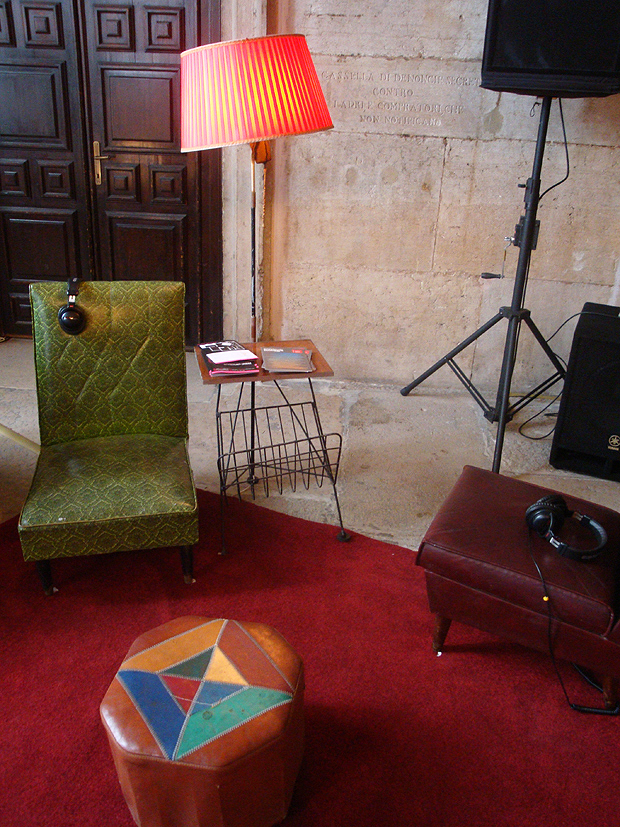 Sound bar library at Taiwan pavilion. Photo by Aditi Kulkarni. Venice Biennale 2011.
Sound bar library at Taiwan pavilion. Photo by Aditi Kulkarni. Venice Biennale 2011.
'I think the most important and uninvestigated architectural music-space of our time is the imaginary space made possible by the microphone...a space that does not exist in any form in any place in the everyday world.' (Ashley,r. 2009 cited in Hong-Kai Wang, 2011. p.17)
In her artist statement Hong Kai Wang quotes American avante-garde composer Robert Ashley, and I found these lines especially relevant. My aim is to transport the audience to Mumbai, my hometown and I agree that this relation between sound and essence of place, though immensely powerful is often ignored.
Reference: Hong-Kai Wang. (2011). Music While We Work. Venice: Palazzo Delle Prigioni. Notes: The Heard and the Unheard: Soundscape Taiwan. The Exhibition of theTaipei Fine Arts Museum of Taiwan. The Taipei Fine Arts Museum of Taiwan. Curator: Amy Cheng. Artists: Hong-Kai Wang Yu-Hsien Su.
A Short History of the Shadow
In this book the author explains the history and meaning behind the shadow in western art. Beginning with the shadow's role in the origin of painting, Victor I.Stoichita covers its symbolic significance across history, from Renaissance painters to Picasso, Warhol and even Piaget's child psychology. Over time he explains how the shadow came to represent negativity, or how the shadow was demonized. The excerpt below is from the first chapter which deals with the earliest representations of the shadow, infused with magical properties, and at times representing the soul.
"...As Maspero reminds us in his classic study, the shadow was how the Egyptians first visualized the soul (ka). In this case it was a 'clear shadow, a colored projection, but aerial to the individual, reproducing every one of his features'. And the black shadow (khaibit), having been regarded in even earlier times as the very soul of man, was subsequently considered to be his double." [pg 19]
An interesting point brought up was the difference between a shadow in sunlight and a shadow at night. He says "..a shadow in sunlight denotes a moment in time and no more than that, but a nocturnal shadow is removed from the natural order of time, it halts the flow of progress." This is relevant because day versus night is a recurring theme in my work since October last year. It also reminded me of the work Tobari no Akari, which to me signified stillness and a frozen moment in time due to the use of nocturnal shadows.
The author's comparison of specular representations with the shadow is also relevant to my work. For example mirrors and reflections in water represent a double (mimesis or likeness) of the real object or person, whereas the shadow can represent the other: "The frontal relationship with the mirror is a relationship with the same, just as the relationship with the profile was a relationship with the other." Giorgio Vasari, The Origin of Painting, 1573, fresco Casa Vasari, Florence.[pg.41]
The book lead me to question the role and significance of the shadow in my work. I've used the shadow in my first installation as a negative symbol to represent the darker hidden city. Whereas in collaborative work such as Tobari no Akari and concept work Beedi Leaf the significance is contextual and at times open to interpretation. Similarly the author underlines the changing meaning of the shadow, "...we could say that to Lippi the shadow as a symbol, is an interminably interpretable symbol." [pg.82]
Although my study of the shadow as a signifier will continue, I cannot find much information about the history of the shadow in Indian or Eastern Art. Besides brief excerpts on shadow puppetry I've discovered only limited information on the significance behind this ancient tradition.
Update: More on the significance of the shadow in the east here.
Reference
Stoichita,V (1997). A Short History of the Shadow. London: Reaktion Books Ltd.
Turner,C and Stoichita,V (2007). A Short History of the Shadow: Interview with Victor I. Stoichita. Cabinet Magazine Issue 24 [online] Available from http://www.cabinetmagazine.org/issues/24/stoichita.php [Accessed 26th April 2011].
Warner, M (2007). Darkness Visible Cabinet Magazine Issue 24. [online] Available from http://www.cabinetmagazine.org/issues/24/Warner.php [Accessed 26th April 2011]
Group Critique
During the group critique I spoke about projecting the filmed cityscape outdoors, and the importance of capturing the essence of the city. Leigh Clarke reacted with a wide range of comments about the work. His main point was that the sound was more powerful than the time-lapse video since it allowed the audience to imagine a larger, more ambiguous space.
He also mentioned that my background as a privileged member of society, and the subsequent "god-like" perspective referred to the panopticon and I should be cautious about the meanings inferred from such choices. Tracey Emin's Folkstone work was mentioned in relation to illustrating a place by using one powerful symbolic object. Leigh Clarke felt that I should focus on a particular object or section of the city instead of trying to describe the entire "forest." He commented that I needed to have an original view of the city rather than something which has been seen before. Ai Weiwei's work Sunflower Seeds 2010 was also mentioned, however I am of the opinion that the work has little relation to mine since I'm looking at sharing the darker, hidden city. In terms of capturing essence however the work is relevant due to the clever play on porcelain versus sunflower seeds, and the issue of handcrafted versus mass-industrialization.
Overall the critique was motivating and provocative because he challenged my project at every level. I explored whether I could go ahead without the visual aspect altogether and looked at various installation concepts that would center around sound as a medium. Another important conclusion was that giving the audience too much information reduced the impact of the work. Overall I realized much more experimentation and research is needed before I can confidently defend my work.
Reference:
Bentham, J (1791). Panopticon Or the Inspection House Vol1 [ebook]. University of Lausanne. Available from: http://books.google.com/ebooks [Accessed 23rd April].
Calvino, I (1997). Invisible Cities. New Edition. London: Minerva.
Emin, T (2008) Baby Things [online] Available from http://www.folkestonetriennial.org.uk/2011-event/artists/2008-tracey-emin/ [Accessed 23rd April 2011].
Foucault, M (1977). Discipline & Punish: The Birth of the Prison [online] Translated from French by Alan Sheridan. Available online from http://www.cartome.org/foucault.htm [Accessed 23rd April 2011].
Kennedy, M (Jan 2011). Ai Weiwei's Sunflower Seeds to go on sale at Sotheby's [online] Available from http://www.guardian.co.uk/artanddesign/2011/jan/26/ai-weiwei-sunflower-seeds-sothebys?INTCMP=SRCH [Accessed 23rd April 2011].
Tate Modern (2010). The Unilevel Series: Ai Weiwei [online] Available from http://www.tate.org.uk/modern/exhibitions/unileverseries2010/default.shtm [Accessed 23rd April 2011].
Place-Making
Notes on urban memory, place-making and its relation to the interpretation of the city in contemporary art and architecture.
During my tutorial with Ronnie Inglis we spoke about the meaning behind the autobiographical trend in my work and further topics of study, especially in relation to place-making. We discussed my previous areas of interest such as the city and fantasy, collective versus personal urban memories, place-making in relation to site-specific art, use of the shadow, and representing extremes. He directed me towards the book History of the Shadow which greatly influenced my work in the following weeks. The topic of Genius loci is relevant because I am interested in shooting my projections in outdoor locations. According to Thompson (2003, p.67) 'the Romans believed that places, like people, had inner spirits that determined their essences,' and similarly I was interested in this essence of Mumbai. Thompson also mentions that for genius loci to be useful rather than a mere magical notion it should be a combination of 'character, local distinctiveness and ecosystem' (2003, p.69). This lead to the idea of representing the city as a fictionalized creation, in the same way a writer creates a fictional character.
And a thing's character changes and develops over time. This can happen slowly or through abrupt events. The reading made me realize that Mumbai has not developed slowly or without trauma. It has grown in bursts and starts. Several traumatic events such as the '93 bombings and the more recent 26/11 Taliban attack have affected the city. We could argue however, that despite these severe shocks the essence of the city remains the same. According to Norberg-Schulz (cited in Thompson, 2003, p.70) "places can change, sometimes rapidly, but this does not necessarily mean that the genius loci changes or gets lost."
An excellent example of the genius loci being kept intact by an architect is the above landscape park Landschaftspark Duisburg-Nord by Peter Latz. The place was 'traumatized by industrialization and deindustrialization' and the architect built upon 'its existing character, creating fern gardens in ore bunkers and making their mass concrete walls into facilities for rock climbers' (Thompson, 2003, p.72). This connects to my idea of using appropriate objects, materials and sites that are relevant to the trauma and violence of the city.
^Cotton 56, Polyester 84 is a play about how the failed Mumbai Mills are getting converted into malls and entertainment complexes. Citizen's groups demand that the land should be converted into open parks and low cost housing, but slowly and surely all mill land will be sold to builders (Shanbag, 2006).
^Another abandoned Mumbai Mill.
As sites these are beautiful and tragic places that express this violent and crushing conflict between the here and the elsewhere, the undesirable and the desired. I can only pursue this direction further once I am back in India. At the same time it brings me to question my interest in these places, since my knowledge of these events is purely historical, through media reports and local people's opinions. At this point in my practice I would prefer to express issues and places that I have personally and directly experienced.
Another important aspect of place is memory, which is in turn closely related to history. Historical buildings such as the mills compounds and their replacements are part of a general history of the city. Individual memories have a completely different flavour. In the book City of Collective Memory the author underlines this difference by proposing that history and memory are bipolar attributes because history is linear and memory non-linear (Boyer, 2001, p.67). Collective memory is 'a current of continuous thought still moving in the present, still part of a group's active life, and these memories are multiple and dispersed, spectacular and ephemeral, not recollected and written down in one unified story' (Boyer, p.67).
Another fascinating point is that this urban memory is 'an antimuseum and not localizable' (Boyer, p.68). This means that my earlier work using popular landscapes and landmarks was a reference to history, a revision of a recognizable historical reality. It is also a reference to memory since I have taken various historical elements and placed them in a contemporary context. Now that I am using scenes that are not famous or instantly recognizable such as the Thane landscape I am removing "historical" elements from the work.
The next topic is framing. We frame the place or city 'by travel, in the theater, at the museum, from the cinema, through its architectural compositions' (Boyer, p.70). The panorama as a framed image is questionable - the city of the panorama is criticized for its 'rational scientific methods,' 'describable pasts' and 'predictable futures' (Boyer, p.68). The author criticizes common recycled views of the city saying 'We have learned to gaze upon the city as artifact through illustrated portfolios and architectural guidebooks that have their own procedures for characterizing place and tradition' (Boyer, p.69).
And finally I'll quote Victor Burgin (1996, p.7) who says that 'we cannot know a 'city', only those of its places we come to frequent.'
Reference
Boyer, C (2001). The City of Collective Memory, Its Historical Imagery and Architectural Entertainments. MIT Press.
Burgin, V. (1996). Some Cities. London: Reaktion Books Ltd.
Thompson, I. (2003). What use is the genius loci? In: Menin, S.(eds). Constructing Place, Mind and Matter. London: Routledge. pp.66-76.
Pile, S. and Thrift, N. (2000). City A-Z. London: Routledge
Wikipedia. (2011). Urbanism [online] Available from http://en.wikipedia.org/wiki/Urbanism. [Accessed 23rd April 2011].
Modern Drawings
Drawings of life in the city, and abstract dream cities. From the exhibition Picasso to Julie Mehretu, modern drawings from the British Museum collection [7th Oct 2010 to 25th April 2011].
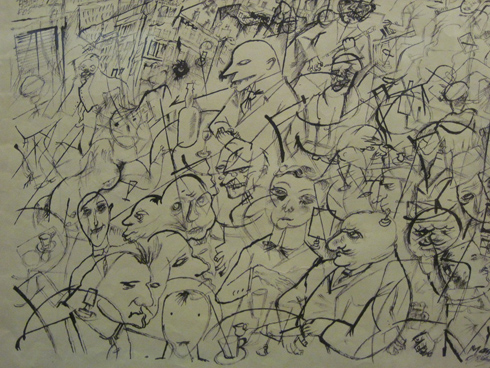 People in a Cafe, 1917 by George Grosz. [Image Source]
People in a Cafe, 1917 by George Grosz. [Image Source]
 Dreamland Tower, Coney Island 1912 by David Milne (1882-1953). [Image Source]
Dreamland Tower, Coney Island 1912 by David Milne (1882-1953). [Image Source]
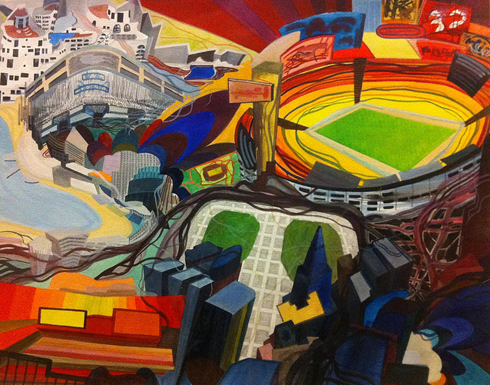 Untitled (Pacific No. 32, weekend), 1998 by Franz Ackermann. [Image Source]
Untitled (Pacific No. 32, weekend), 1998 by Franz Ackermann. [Image Source]
 Untitled (City Abstraction) 1912 by Abraham Walkowitz. [Image Source]
Untitled (City Abstraction) 1912 by Abraham Walkowitz. [Image Source]
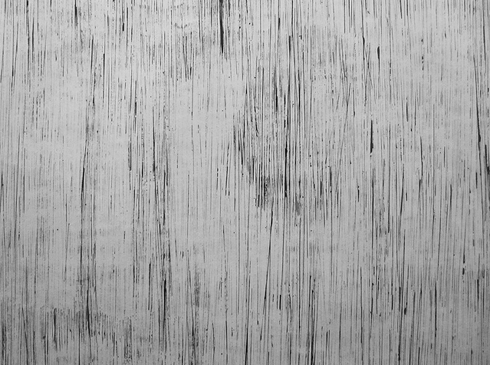 Vertical Lines 1953 by Kazuro Nakamura. [Image Source]
Vertical Lines 1953 by Kazuro Nakamura. [Image Source]
 Untitled by Lawrence Weiner (born 1942) [Image Source]
Untitled by Lawrence Weiner (born 1942) [Image Source]
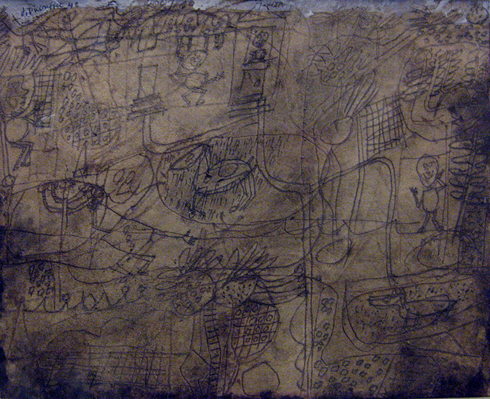 Grotesque Landscape in Yellow 1949 by Jean Dubaffet (1401-85) Pen and ink on yellow watercolour. [Image Source]
Grotesque Landscape in Yellow 1949 by Jean Dubaffet (1401-85) Pen and ink on yellow watercolour. [Image Source]
Update 4th May: I've only included work that is relevant to my project on representing the atmosphere of the city. In my journey towards representing the violence between the fantasy and the real within Mumbai, I've noticed a trend towards abstraction especially with the increasing use of shadows and reflections within the installation. These drawings capture this urban feeling in their own individual expressionist ways.
Museum Visit
A trip to London ended up at the British museum. Most of the work I found inspiring were from the Africa rooms:
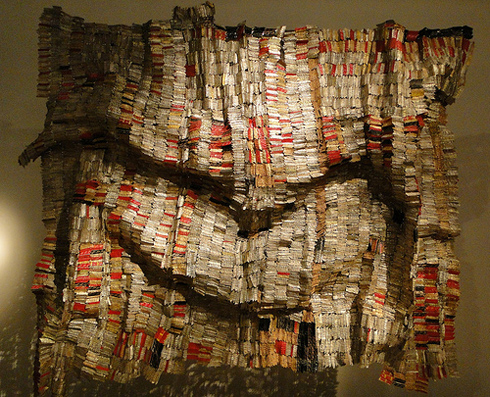
Man's Cloth. Recycled metal foil bottle-neck wrappers, copper wire. By El Anatsui, Ghana, 1998-2001. Image 1 Source. Detail photograph taken at the British Museum April 2011.
Throne of weapons, by Kester, Maputo, Mozambique, 2001. Made of decommissioned weapons from the Mozambican civil war in 1992. Exhibited at Room 25 Africa at the British Museum (April 2011).
Tree of Life Made by Kester, Hilario Nhatugueja, Fiel dos Santos and Adelino Serafim Maté. Maputo, Mozambique, 2004. Photo © 2005 Christian Aid / David Rose.
Part of the sculpture Tree of Life Made by Kester, Hilario Nhatugueja, Fiel dos Santos and Adelino Serafim Maté. Maputo, Mozambique, 2004. Photo by Aditi Kulkarni at the British Museum Room 25: Africa.
Otobo (Hippo) masquerade, made by Sokari Douglas Camp, 1995. Steel, paint, wood and palm stem brooms. British Museum April 2011. More details.
Glazed stoneware figure of a judgement group, Ming Dynasty, China, 16th century. Photo taken at British Museum, Asian Gallery.
Housepost, Iatmul people, Sepik River, Papua New guinea, 1900-1950.
Kanga display, Africa room, British Museum, April 2011.
Dark Stuff
I stumbled on the work Dark Stuff (2008) while looking at random postcards being sold at the British Museum in London. Tim Noble and Sue Webster had created an impressive image inspired by Egyptian mummies, and it motivated me to look for more of their work. Then I found Sunset in Manhattan (2003).
Dark Stuff, 2008 by Tim Noble and Sue Webster 189 mummified animals (67 field mice, 5 adult rats, 42 juvenile rats, 44 garden shrews, 1 fox, 1 squirrel, 1 weasel, 13 carrion crows, 7 jackdaws, 1 blackbird, 1 sparrow, 1 robin, 1 toad, 1 gecko, 3 garden snail shells), glue, metal stands, light projector [Visit Image Source]
Sunset over Manhattan, 2003 Cigarette packets, tin cans shot by air gun pellets, wooden bench, light projector 110 x 31 x 75 cm (431/3 x 121/4 x 291/2 in) [Visit Image Source]
Here the use of rubbish combined with light and shadow creates a city that is recognizable as Manhattan, and at the same time makes an important comment about the place itself. At this point in my project I explored the use of objects in my installations and what kind of objects would be relevant to the concept of the fantastical and the real.
Genius Loci
In phase one I succeeded in defining my area of study, learning about projecting video, building installations, and the limitations involved. Phase two is about capturing a "feeling" of Mumbai. But what is this feeling, this intangible "sense of place," and how can I create a space that communicates it effectively. The city is a multi-layered, complex and rich experience. No one has identical perceptions of something that is so much in flux, so huge in scale. At the same time there is an underlying recognition of its flavour, a distinctive personality that can be called its Genius Loci. In trying to pinpoint this atmosphere of Mumbai, something which is intrinsic in my memories of the city, and which all Mumbaikars are familiar with, I questioned my original plan of building a 360 panorama in a closed studio space.
An outdoor location is one of the ways I plan to solve this riddle. Although it is technically difficult to build an installation outside a controlled studio set-up, I am of the opinion that the right place can physically represent the city, and communicate a lot more than well-edited video or sound ever could.
Place-making is discussed in detail here.
Reference
Menin, S. (2003). Constructing Place Mind and Matter. London: Routledge.
Personal Bibliography
A complete alphabetical list of relevant books, articles, websites, film, video, exhibition, journals and lectures referenced in Phase 1 of the MA Interactive Media course.
A list of relevant books, articles, websites, film, video, exhibition, journals and lectures referenced in Phase I, Phase II and Phase III. More links on my delicious account.
Ali, Atteqa. Postmodernism: Recent Developments in Art in India. InHeilbrunn Timeline of Art History. New York: The Metropolitan Museum of Art, 2000–. http://www.metmuseum.org/toah/hd/pmin/hd_pmin.htm (October 2004)
Ananthakrishnan, G. (2010). Mumbai Diwali Decibel Levels: Cold Comfort. Nov.6th 2010. Digital Journo. [online]. Available from: http://digitaljourno.wordpress.com/2010/11/06/mumbai-diwali-decibel-levels-cold-comfort/ Accessed 14th May 2011.
Ashraf, K Kazi. (2005) Masala City: Urban Stories from South Asia. The New Mix: Culturally dynamic architecture, Sara Caples and Everardo Jefferson, Architectural Design. Vol 75, No 5 Sept/Oct 2005, pp.67-68.
Barry, A (2000). Noise. In: Pile, S. and Thrift, N. (eds.) City A-Z. London: Routledge.
Barjatya, S. (2003). Mein Prem Ki Diwani Hoon. [Film]. India: Rajshri.
Bendikson, Jonas. (2008). The Places We Live [online]. Available from: http://www.theplaceswelive.com/ [Accessed 1st Nov. 2010] Dominic M. McIver Lopes. (2001).
Bentham, J (1791). Panopticon Or the Inspection House Vol1 [ebook]. University of Lausanne. Available from: http://books.google.com/ebooks [Accessed 23rd April].
Benjamin, A. (2010). Trauma within the Walls: Notes towards a Philosophy of the City. Architectural Design. Vol. 80. No.5. pp.24-31.
Bickle, B. (2011). Seeing Ourselves. Zimbabwe Pavilion: Venice
Bombay Railway. Episode 1. Pressure. (2007). UK. BBC Four. 9th Sept. 2007. [Television]
Boyer, C (2001). The City of Collective Memory, Its Historical Imagery and Architectural Entertainments. MIT Press.
Blazwick, I. (2001). Century City: Art and Culture in the Modern Metropolis. London: Tate Gallery Publishing Ltd.
Burgin, V. (1996). Some Cities. London: Reaktion Books Ltd.
Bugada and Cargnel. (2011). Nico Vascellari. [online]. Available from: http://www.bugadacargnel.com/en/pages/artistes.php?name=21891. Accessed 21st June 2011.
Burke, A. (2010). The Urban Complex: Scalar probabilities and Urban Computation. Architectural Design. Vol. 80. No.5. pp.87-91.
Calvino, I (1997). Invisible Cities. New Edition. London: Minerva.
Cole, D. (2007). Patterns: New Surface Design. London: Lawrence King Publishing
Cotter, H. (2005). Objects of Repose and Remembrance. New York Times. [online]. Available from: http://www.nytimes.com/2005/03/30/arts/design/30cott.html?ex=1172638800&en=840b508f152bce9e&ei=5070 Date Accessed: 21st July 2011.
Danto, A. C. (1995). After the End of Art: Contemporary Art and the Pale of History. Princeton, New Jersey: Princeton University Press.
Dali, S. (2011). The Dali Universe. Venice: Fondazione Ambrosiana Per L’Arte E La Cultura
Degen, N. (2008). Dayanita Singh. Frieze Magazine. [online]. Available from: http://www.frieze.com/shows/review/dayanita_singh/. Accessed: 21st July 2011.
Design Observer Blogs. (2010) Uncanny: Surrealism and Graphic Design. Available from: http://observersroom.designobserver.com/rickpoynor/uncanny.html [Accessed 15th May 2011].
Dictionary of Media Studies (2006). p. 121. A&C Black Publishers: London
Emin, T (2008) Baby Things [online] Available from http://www.folkestonetriennial.org.uk/2011-event/artists/2008-tracey-emin/ [Accessed 23rd April 2011].
Eddistribution (2008) Robinson dans l'espace de Patrick Keiller [online]. Available from: http://www.youtube.com/watch?v=wBHgQBBgogc [Accessed 11th Jan 2011].
Foucault, M. (1984) Des Espace Autres. Architecture /Mouvement/ Continuité. [online] Oct. 1984. Translated from French by Jay Miskowiec. Based on a lecture by Michel Foucault on March 1967. Available from: http://foucault.info/documents/heteroTopia/foucault.heteroTopia.en.html. [Accessed 5th Jan 2010]
Foucault, M (1977). Discipline & Punish: The Birth of the Prison [online] Translated from French by Alan Sheridan. Available online from http://www.cartome.org/foucault.htm [Accessed 23rd April 2011].
Galerie Leonard & Bina Ellen Art Gallery (n.d.). Ways of Thinking: Works. [online] Available from: http://ellengallery.concordia.ca/en/reflexion_hadjithomasjoreige.php [Accessed 18th Dec. 2010]
Green, C. (2001). The Third Hand: Collaboration in Art from Conceptualism to Post-Modernism. University of Minnesota Press: USA.
Hales Gallery. (2010). Dawn Clements: Still Life. London: Hales Gallery
Hirschhorn, T. (2011). Crystal of Resistance. Biennale Di Venezia, Padiglione Svizzero.
Hong-Kai Wang. (2011). Music While We Work. Venice: Palazzo Delle Prigioni.
Johar, K. (1998). Kuch Kuch Hota Hai. [Film]. India: Dharma Productions.
Kaye, N. 2000. Site-Specific Art: Performance, Place and Documentation. Routledge: London
Kennedy, M (Jan 2011). Ai Weiwei’s Sunflower Seeds to go on sale at Sotheby’s [online] Available from http://www.guardian.co.uk/artanddesign/2011/jan/26/ai-weiwei-sunflower-seeds-sothebys?INTCMP=SRCH [Accessed 23rd April 2011].
Kitwise. (2010). Summertime 1-4 [online]. Available from: http://www.youtube.com/watch?v=hWlk1KIysqQ&feature=player_embedded#! [Accessed 11th Jan 2011].
Kit Wise. (2010). Xanadu [online] Available from: http://www.kitwise.com/ [Accessed 10th Jan 2011].
Lang, F. (1927). Metropolis. [Film]. Germany: Universum Film.
Lahoud, A. (2010). Post Traumatic Urbanism. Architectural Design. Vol. 80. No.5. pp.14-23.
luxmovingimage. (2009). Chris Welsby – Artist Interview. [online]. Available from http://www.youtube.com/watch?v=o3fdZewJc3Y&feature=player_embedded#at=20 [Date accessed 3rd April 2011]
Merleau-Ponty. 1962. Phenomenology of Perception. Routledge: London.
Muybridge, E. (2010). The Panorama of San Francisco from Street Hill 1878. Eadward Muybridge. London: Tate Britain
Malani, Nalini. Remembering Toba Tek Singh. (1998). Installation view Queensland Art Gallery, Brisbane, Australia. 2002 [Installation with video projection on walls, 12 monitors with video clips, tin trucks, quilts, and Mylar flooring]
Mazumdar, Ranjani. Bombay Cinema : An Archive of the City. Minneapolis, MN, USA: University of Minnesota Press, 2007. p 18, 19, 120. http://site.ebrary.com/lib/aib/Doc?id=10206194&ppg=18 Copyright © 2007. University of Minnesota Press. All rights reserved.
Mackey, S. (2010). Practice as Research: Performance, Place and Documentation. Arts University College at Bournemouth. 9th November.
Mermin, L. (2008). Shot in Bombay. [Film]. UK: Little Bird
Maeda, J. (2006). No Crackle Pop [online]. Available from: http://www.maedastudio.com/2006/burn/index.php?category=all&next=exists&prev=exists&this=burn [Accessed 21st October 2010].
Mertens, B. 2008. The artist Navin Rawanchaikul calls for Navins of the world to unite. The New York Times. [online]. Available from: http://www.nytimes.com/2008/01/29/arts/29iht-mertens.1.9573662.html?_r=1. Accessed 25th July 2011.
Moravian Gallery in Brno. (2010). Uncanny: Surrealism in Graphic Design by Rick Poynor.[online]. Available from http://www.moravska-galerie.cz/moravska-galerie/vystavy-a-program/aktualni-vystavy/2010/cosi-tisniveho-surrealismus-a-graficky-design.aspx Accessed [15th May 2011].
Menin, S. (2003). Constructing Place Mind and Matter. London: Routledge.
Naik, Y. and Khera, D. (2011). IIT-B Demands Noise Barriers. Mumbai Mirror. [online]. April 17th 2011. Available from: http://www.mumbaimirror.com/article/2/2011041720110417030951301232b713d/IITB-demands-noise-barriers.html [Accessed: 13th May 2011].
NationalGeographic. (2009). Amazing Northern Lights Time Lapse. [online]. Available from: http://www.youtube.com/watch?v=FcfWsj9OnsI [Accessed 29th Dec. 2010]
Noe, G. (2009). Enter the Void. [Film]. France: Fidélité Films.
Pallasmaa, J. (1996). Eyes of the Skin: Architecture and the Senses. John Wiley and Sons: USA
Parasol Unit. (2010). Adel Abdessemed: Silent Warriors. London: Parasol Unit
Patwardhan, Sudhir. Ulhasnagar. (2001). [online image]. Available from: http://www.sudhirpatwardhan.com/paintings.htm [Accessed 21st October 2010]
Patwardhan, S. (patwardhansudhirATyahoo.com). 18th October 2010. Re: Questions from an art student. Email to A.Kulkarni.(aditi.aduATgmail.com)
Per Bak. (1996). How Nature Works: The Science of Self-Organised Criticality. Copernicus Press: New York.
Protazanov, Y. (1924). Aelita: Queen of Mars. [Film]. Soviet Union: Mezhrabpom-Rus
Prigov, D. (2011). Dmitri Prigov: Dmitri Prigov: Hermitage Project 20/21. Venice: Ca' Foscari.
Poynor, R (2011). Surrealism in Graphic Design. Arts University College Bournemouth. 13th May.
Pile, S. and Thrift, N. (2000). City A-Z. London: Routledge
Rawanchaikul, N. 2011. Paradiso Di Navin: A Mission to Establish Navinland. Paradiso Gallery: Venice
Rebello, S and Lohade. U. (2011). Sound and fury in Mumbai. Hindustan Times Mumbai. [online] April 20, 2011. Available from: http://www.hindustantimes.com/StoryPage/Print/687364.aspx [Accessed 12th May 2011].
Russolo, L. (1967). The Art of Noise, futurist manifesto 1913. [pdf]. Something Else Press. Available from: http://www.ubu.com/historical/russolo/index.html [Accessed 13th May 2011].
Sowin, J. (2006). In Praise of Shadows: A Meditation. [online]. Available from:http://www.fireandknowledge.org/archives/2006/09/23/in-praise-of-shadows-a-meditation/ [Accessed 17th August 2011].
Scott, R. (1982). Blade Runner. [Film]. USA: The Ladd Company
Stoichita,V (1997). A Short History of the Shadow. London: Reaktion Books Ltd.
Tate Modern (2010). The Unilever Series: Ai Weiwei [online] Available from http://www.tate.org.uk/modern/exhibitions/unileverseries2010/default.shtm [Accessed 23rd April 2011].
Tanizaki, J. 1977. In Praise of Shadows. Leete’s Island Books: USA
Terror in Mumbai. (2009). UK. HBO. 30th June 2009. [Television]
Turner,C and Stoichita,V (2007). A Short History of the Shadow: Interview with Victor I. Stoichita. Cabinet Magazine Issue 24 [online] Available from http://www.cabinetmagazine.org/issues/24/stoichita.php [Accessed 26th April 2011].
Turrell, J. (2011). Ganzfield. Venice: Arsenale.
Thompson, I. (2003). What use is the genius loci? In: Menin, S.(eds). Constructing Place, Mind and Matter. London: Routledge. pp.66-76.
The Ontology of Interactive Art. Journal of Aesthetic Education [online] Vol. 35, No. 4 (Winter, 2001), pp. 65-81 Available from: http://www.jstor.org/stable/3333787 [21st October 2010]
Moraes, D. (1983). The Great Cities: Bombay. Second Edition. Amsterdam: Time-Life Books B.V.
TinType. (2010). Suki Chan: Utopia on the Horizon. London: TinType
UN-HABITAT. (2010), State of the World’s Cities 2010/2011: Bridging the Urban Divide. London: Earthscan. Available from: http://www.unhabitat.org/pmss/listItemDetails.aspx?publicationID=2917 [Accessed 28th Oct. 2010]
Van Hagen, J. (2010). Archichaos. London: ArtStanding
Victoria Miro. (2010). Yayoi Kusama: Flowers that Bloom Tomorrow. London: Victoria Miro
Warner, M (2007). Darkness Visible Cabinet Magazine Issue 24. [online] Available from http://www.cabinetmagazine.org/issues/24/Warner.php [Accessed 26th April 2011]
White Cube. (2010). Mark Bradford: The Pistol that Whistles. London: White Cube
Walsh Gallery. (2007). Nalani Malani: Mother India: Transactions in the Construction of Pain [online]. Available from http://www.walshgallery.com/nalini-malani-mother-india-transactions-in-the-construction-of-pain/ [Accessed 25th October].
Welsby, C. (1972) British Artist’s Films, Chris Welsby. [DVD]. BFI.
West, G. (2011). The Surprising Math of Cities and Corporations. [online]. Available from http://www.ted.com/talks/geoffrey_west_the_surprising_math_of_cities_and_corporations.html [Accessed 2nd Aug. 2011].
Wikipedia (2011). The Art of Noises. Available from: http://en.wikipedia.org/wiki/The_Art_of_Noises [Accessed 13th May 2011].
Wikipedia. (2011). Urbanism [online] Available from http://en.wikipedia.org/wiki/Urbanism. [Accessed 23rd April 2011].
Yerly, S. (2009). Pier Stockholm. 23rd October 2009. We Find Wildness [online]. Available from: http://www.we-find-wildness.com/2009/10/pier-stockholm/ [Accessed 13th November 2o10]
Reflection
The first turning point was a discussion with Phil Beards about focussing my topic of interest for the MA. Based on Phil's suggestion, I ended up brainstorming and created a mind map which outlined the proposed area of study.Initially I was uncertain about which bipolarity I should study and looked at several opposing factors within Mumbai such as ugly and beautiful and poverty versus luxury. During the course of my research on Mumbai's architecture, I stumbled on an article by Ashraf K. Kazi (2005) where he mentions the concept of elsewhere and it's relation to the evolving architecture of Mumbai city. This conflict between the elsewhere and the here was the perfect example of bipolarity; juxtaposing the luxurious pseudo-greek high rises of Hiranandani with the crowded squalor of the Tunga slums.
A brainstorming discussion with Liam Birtles helped expand my thoughts on the final installation work. We discussed several ideas and technical possibilities, hidden cities, the use of shadow, and how time could also be a factor within the installation. Eventually the most important event was the installation test in December which helped me see my work in it's intended medium for the first time. Several issues needed much more thought such as the use of space, time and sound and how these could in turn interact with the audience while flowing with the theory and concept. This first experimental installation and the consequent discussions and findings helped clarify my concept and goals for phase 1.
A string of events in the last two and a half weeks of phase 1 helped synthesize my aims and theoretical framework. A peer critique encouraged me to continue using real shadows and a group critique steered me towards the works of Kit Wise and theories of heterotopia. While creating the presentation for the group critique I also analyzed and listed the technical limitations of my current installation experiments. And a final tutorial with Phil helped me start planning for Phase 2 and the use of interactive sound.
Phase 1 was an experimental phase, just like the final work from Phase 1 is an experiment and not a formal installation to be placed in an art gallery. Several factors will be taken into account for Phase 2, based on the findings of the installation experiment conducted on 20th of January. These will probably include research into the history of shadows, use of sound, technical details, coding, the 360 panorama and how these additional layers could affect the audience experience. Most importantly phase 2 will not be an experimental phase, but a project phase which will focus on the dissemination and application of my practice.
Reference
Ashraf, K Kazi. (2005) Masala City: Urban Stories from South Asia. The New Mix: Culturally dynamic architecture, Sara Caples and Everardo Jefferson, Architectural Design. Vol 75, No 5 Sept/Oct 2005, pp.67-68.
Research Methods: Phase 1
A detailed look at the theoretical framework and research methods behind my practice in Phase 1. Key issues discussed are practice as research, the post-digital age, heterotopia, qualitative research methods, and limitations of these methods.
We've had several inputs on practice as research, however Dr. Sally Mackey's lecture helped clarify my ideas on the topic. Besides talking at length about the praxis between theory, reflection, action and practice she also mentioned creating a laboratory; an ideal set-up that would help answer and clarify the key questions of the research. The lab I have created is an installation space that allows the audience to interact with the work and each other. By continually experimenting in this interactive space I am able to clarify my key questions and focus my research topic further.
Currently I am attempting to transform a range of questions into one key point. Below is a list of possible topics of enquiry: How does the user's interaction with the space help add meaning to the work Mumbai+Bombay? How can an interactive space illustrate the conflict between the ideal elsewhere and the here in Mumbai? How does audience behavior and expectation affect the perceived meaning of the work Mumbai+Bombay? What is the perceived difference between an "insider" and "outsider" in viewing the work Mumbai+Bombay?
Dissemination and Application: Another important factor to consider is the dissemination of the final work. The web is the most easily accessible form the final work can take. Additionally, the work can be set up in a gallery or informal space as a more immersive experience of changeable dimensions.
Theoretical Framework:
Post Digital Age: As mentioned in my preliminary Study Plan the concept of a post-digital age introduced by John Maeda made a significant impact on my philosophy as a designer of interactive media. The terms clarifies the 'distinction between those that are passed their fascination with computers, and are now driven by the ideas instead of the technology (John Maeda, 2006).’
Heterotopia's and 'Other' Spaces:
Michel Foucault (1967) describes heterotopias as "places that do exist and that are formed in the very founding of society - which are something like counter-sites, a kind of effectively enacted utopia in which the real sites, all the other real sites that can be found within the culture, are simultaneously represented, contested, and inverted. Places of this kind are outside of all places, even though it may be possible to indicate their location in reality." Thus all cultures and civilizations contain such places. Foucault goes on to describe several different kinds of heterotopias, of which the following were most relevant to my practice.
Heterotopia of compensation: Especially relevant to colonies, these places are contrary by way of compensation and function between two extreme poles (Foucault, 1967):
"...their role is to create a space that is other, another real space, as perfect, as meticulous, as well arranged as ours is messy, ill constructed, and jumbled. This latter type would be the heterotopia, not of illusion, but of compensation, and I wonder if certain colonies have not functioned somewhat in this manner. In certain cases, they have played, on the level of the general organization of terrestrial space, the role of heterotopias."
Another example of a heterotopia is the "persian garden," where several plants and flowers from around the world co-exist in a small place which is like a microcosm of the larger world; "the garden is the smallest parcel of the world and then it is the totality of the world. The garden has been a sort of happy, universalizing heterotopia since the beginnings of antiquity..." Similarly by constructing a limited cityscape which includes as many landmarks and symbols as possible, I will attempt to explore this "other" space within Mumbai.
Research Methods
Qualitative Research: Systematic study of Mumbai and the ways the city is represented in popular media and art. Typical of qualitative research, this included looking at chosen media and art works in a case-based method. Each film, artwork, architectural style or documentary chosen for study was reviewed in detail. Thus the method encouraged looking into each case study in-depth rather than covering a broad overview of every possible representation of the city.
Interviews: Sudhir Patwardhan is an important artist within the Indian contemporary art movement, and his practice centers on Mumbai and it's people. Deeply influenced by his work Silent Town (2007) I contacted him by email in the beginning of Phase 1 for pointers on which artists and books I should study, since I found the lack of information of Indian contemporary art challenging. Here is an excerpt from his email which answers some of my questions:
Reflexive Journal: Commonly used as part of qualitative research, a regularly updated reflexive journal of my thoughts, comments and ideas helped document my progress. The journal or blog is a complimentary annotation to the work.
Analysis of documents and materials: A continuous process of reviewing the cases studies, and their importance in answering the research questions. An important factor was reviewing the source itself, it's reliability and validity.
Analysis
In trying to maintain a "polyphonic conversation" between my practice and my research I have fallen into a method which is similar to a communication design process. The cyclical process-driven method of research Sally Mackey calls "praxis" is another way to describe the "design process" - a rigorous method of study and design followed by reflection, study and more design. One main difference is the stage of user-testing that most often precedes another round of reflection.
Phase 1 consisted of a similar cyclical research method. Creating a lab, or in this case an installation space where I can test the limits of my key questions, and then going back to the drawing board based on the results. This cycle of experiment, reflection and experiment helped clarify my theoretical framework as well as my practice. An important aspect of my reflection was discourse, relevant conversations with peers, faculty and artists.
Data collection and analysis of what was relevant to the project was challenging due to the significant amount of information available. Process involved choosing case-studies based on relevance to the project, and discarding information that did not fit within the required parameters such as visual style, architecture, historical significance, concept and theoretical framework. At the same time the lack of information within certain areas proved difficult. The information on the development of contemporary art in India was limited and in some cases contradictory. The history of Mumbai itself is long and complicated, a series of conflicts with contrary histories. Some of these issues resolved themselves in time through action. Others clarified when I drew on six years of personal experience, living as a Mumbaikar.
Another hurdle is my limited access to Mumbai itself. To overcome this, I will be travelling to Mumbai for ten days to collect information, visit artists, shoot films and record street sounds based on my findings in Phase 1.
Despite the above mentioned limitations, maintaining regular blog entries of my progress allowed me to pinpoint and correct events that were most influential or most detrimental to the development of my practice, and critically review the leaps I made from research to practice or vice versa.
Reference:
John Maeda. (2006). No Crackle Pop [online]. Available from: http://www.maedastudio.com/2006/burn/index.php?category=all&next=exists&prev=exists&this=burn [Accessed 21st October 2010]
Foucault, M. (1984) Des Espace Autres. Architecture /Mouvement/ Continuité. [online] Oct. 1984. Translated from French by Jay Miskowiec. Based on a lecture by Michel Foucault on March 1967. Available from: http://foucault.info/documents/heteroTopia/foucault.heteroTopia.en.html. [Accessed 5th Jan 2010]
Mackey, S (2010). Practice as Research: Performance, Place and Documentation. Arts University College at Bournemouth. 9th November.
Patwardhan, S. (patwardhansudhirATyahoo.com). 18th October 2010. Re: Questions from an art student. Email to A.Kulkarni.(aditi.aduATgmail.com)
Documentary: Bombay Railway
Bombay Railway is a two-part documentary by BBC 4 that paints a picture of an overcrowded train system pushed to its limit by 6 million commuters a day, full of people who strive towards their goals tirelessly, in the city of dreams that is Mumbai. I was a frequent traveller myself, so it was interesting to watch the documentary which is from the point of view of an observer rather than someone who has lived the experience. What we call "Crush" is the super rush hour that's also mentioned in the film, and the statistics and video footage is more frightening than actually travelling in the crowd. As an observer, the sight of 5000 or more people getting into trains meant for 1200 people within 30 seconds is a spectacle. As a participant it's an exciting, thrilling, and somewhat harrowing daily reality. The fact is that the local trains are cheap, charging about 1 penny a mile and the trains are always on time with a 97% efficiency, so despite the odds the system is dependable and vital to the normal functioning of Mumbai.
In the first part of the film, the stories about runaway kids living on Mumbai platforms sounds sunny and positive, giving the audience hope that things could turn out well for these children that have escaped abusive families. However describing a railway station as a "family" where you get to "be yourself" is overly optimistic and misleading. Most of these runaways end up being abused, drugged and treated badly. I have seen them being thrashed by cops or others on more than one occasion. Life for kids in such places is rarely a happy place.
Various other issues such as illegal hawking, crossing tracks, and the terrorist bombings are also mentioned. Below are a few screenshots from the film:
Documentary: Shot in Bombay
[vimeo http://www.vimeo.com/6735583] The documentary uses a lot of "typical" shots of Mumbai, shots of the streets, children, and film sets, with catchy Bollywood music in the background. The opening sequence above is especially successful in creating a rich, romantic atmosphere. Here are some screenshots from the sequence which best represent this slice of the city:
Related Posts that study the city's representations in the media: Bombay Cinema, An Archive of the City | Elsewhere Places | Bombay Book Cover | 26/11 Attack | Dharavi Documentary | Places we Live
Group Critique
Overall Feedback:Brian Catling (performance artist and poet) mentioned that I could add a layer of virtual shadows to the video installation, in addition to the real shadows thrown by the audience. He also mentioned that since the user's action is central to viewing the work, it's almost as if the user is causing the resulting violence/action, in this case the image of a burning building that becomes visible only in the user's shadow. In answer to my question about the kind of space I should use for the installation, he said that using a clean, "constructed" white room would work best with the concept. There was a brief discussion on the lack of sound used, and he thought that sound was not required at all.
Several artists and films that could help develop my practice were mentioned: such at Kit Wise, Rope by Hitchcock and "London" and "Robinson in Space" by Patrick Keiller. I was also directed to Foucault's theories of Heterotopia, Dystopia and Utopia; "Non Places - Introduction and an Anthropology of Super Modernity" by Mare Ange and the History of the Shadow by V. Strichita.
Reflection: The use or lack of sound is an important issue which I still have to properly integrate into the concept of the bipolar, constructed realities. However I agree with Brian in that the sound itself is not very important to the installation. It is a concern to me that the sound or music could dominate the visuals. The result should be dream-like, since dreams have a tendency to have faded or muted sounds when remembered. Examples of appropriate sounds are: muted voices, very low volume music, or something subtle such as crackling of fire and gunshots in the distance. During the presentation I also realized that a subtle difference between the "here" and the "elsewhere" is better than an overly dramatic and "literal" difference. The space itself is still an issue which I need to work on to some extent. A large part of phase 2 will be building on the space, experimenting with the use of objects along with projectors, and trying the 360 degree panorama. Overall, creating the presentation helped me organize my thoughts in terms of the kind of framework and process I followed, looking at the gaps in my reasoning and further steps I needed to take in my research.
Notes: Topics to read further: Para-Feminism, Invisible artwork, Family photographs as imposed memories, Leonard Talmy: Force Dynamic in language: "door is closed" vs the "door cannot be opened." Uses of Enchantment by Bruno: interesting book about fairy tales, Costume vs. Fashion is the folk (narrative, story) vs. elite (market, consumer); Physiology of taste by Brillat Savarin; Dutch golden age (objects with meaning, symbols) - using a room or a window to project against or using meaningful objects in the installation; Shadows: Using shadows in different tones, different light sources. Also interesting is the book Praise the Shadow; Constructed Reality: creating from photographs, memory, or not even that, but just found photographs is one step down. Films: Many Moons (2008) b Janelle Monae; Coraline (animation); Eraserhead by David Lynch













